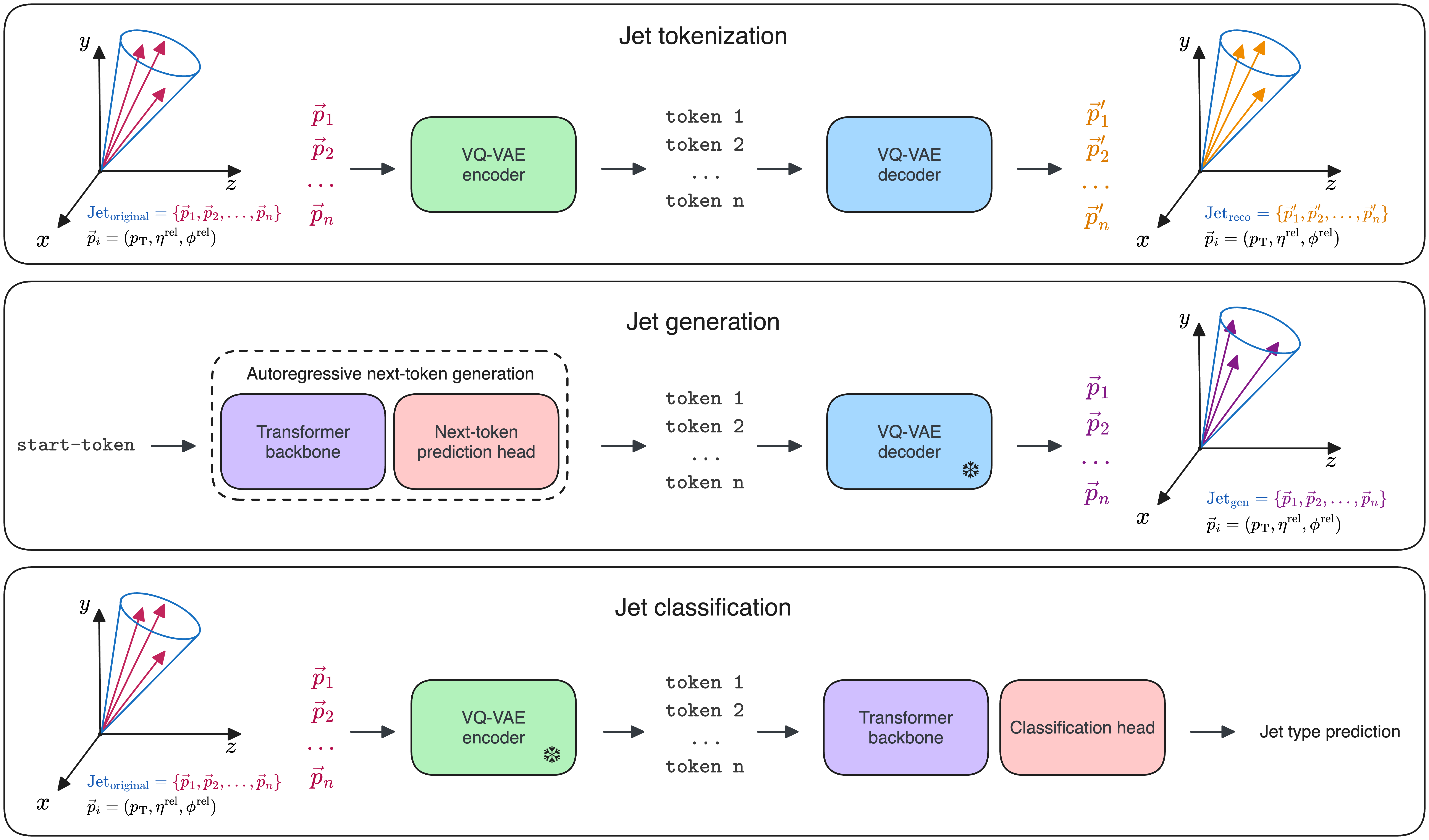This repository contains the code for the results presented in the paper 'OmniJet-α: The first cross-task foundation model for particle physics '.
Abstract:
Foundation models are multi-dataset and multi-task machine learning methods that once pre-trained can be fine-tuned for a large variety of downstream applications. The successful development of such general-purpose models for physics data would be a major breakthrough as they could improve the achievable physics performance while at the same time drastically reduce the required amount of training time and data. We report significant progress on this challenge on several fronts. First, a comprehensive set of evaluation methods is introduced to judge the quality of an encoding from physics data into a representation suitable for the autoregressive generation of particle jets with transformer architectures (the common backbone of foundation models). These measures motivate the choice of a higher-fidelity tokenization compared to previous works. Finally, we demonstrate transfer learning between an unsupervised problem (jet generation) and a classic supervised task (jet tagging) with our new OmniJet-α model. This is the first successful transfer between two different and actively studied classes of tasks and constitutes a major step in the building of foundation models for particle physics.
Table of contents:
Instructions on how to download the dataset can be found in the repository jet-universe/particle_transformer.
The recommended (and by us tested) way of running the code is to use the
provided docker image at
jobirk/omnijet on DockerHub.
Alternatively, you can install the requirements from the docker/requirements.txt file, but
you'll have to add pytorch to the list of requirements, since this is not
included in the requirements.txt file (we use the official pytorch image as
base image).
Furthermore, you'll have to add/create a .env file in the root of the project
with the following content:
JETCLASS_DIR="<path to the jetclass dataset i.e. where the train_100M, val_5M, .. folders are>"
JETCLASS_DIR_TOKENIZED="<path to where you want to save the tokenized jetclass dataset>"
# stuff for hydra
LOG_DIR="<path to log dir>"
COMET_API_TOKEN="<your comet api token>"
HYDRA_FULL_ERROR=1To play around with the already-trained VQ-VAE model, you can download the
checkpoint (see checkpoints/README.md for instructions) and then have
a look at the notebook
examples/notebooks/example_tokenize_and_reconstruct_jets.ipynb.
You can run the training of the VQ-VAE model by running the following command:
python gabbro/train.py experiment=example_experiment_tokenizationYou can then evaluate a tokenization model by running the following command:
python scripts/evaluate_tokenization_ckpt.py --n_eval=100000 --ckpt_path=<path to the checkpoint>The result of the evaluation will appear in a subfolder of the run directory.
To create the tokenized dataset, you can run the following command:
python scripts/create_tokenized_dataset.py --ckpt_path=<path to the checkpoint> --n_files_train=100 --n_files_val=5 --n_files_test=5Make sure to adjust the --n_files_* arguments to your needs, and set the env variable
JETCLASS_DIR and JETCLASS_DIR_TOKENIZED in the .env file.
Afterwards, the tokenized dataset will be saved in if a subdirectory of the
JETCLASS_DIR_TOKENIZED directory and can be used to train the backbone model.
To play around with the already-trained generative model, you can download the
checkpoint (see checkpoints/README.md for instructions) and then have
a look at the notebook
examples/notebooks/example_generate_jets.ipynb.
If you want to run a generative training, you first have to create the tokenized
dataset (see above).
Note that you have to make sure that the checkpoint of the tokenizer is saved/copied
to that directory as model_ckpt.ckpt and the training config as config.yaml
(this is necessary since the gen. training will look for those files to reconstruct
tokens back to physical space).
You can then run the training of the generative model by running the following command:
python gabbro/train.py experiment=example_experiment_generativeYou can run the training of the classifier model by running the following command:
python gabbro/train.py experiment=example_experiment_classificationYou can then evaluate a classifier model by running the following command:
python scripts/evaluate_classication_ckpt.py --ckpt_path=<path to the checkpoint>If you use this code in your research, please cite our paper:
@article{Birk:2024knn,
author = "Birk, Joschka and Hallin, Anna and Kasieczka, Gregor",
title = "{OmniJet-$\alpha$: The first cross-task foundation model for particle physics}",
eprint = "2403.05618",
archivePrefix = "arXiv",
primaryClass = "hep-ph",
month = "3",
year = "2024"
}



